The blues scale is one of the first guitar scales we explore on the guitar when learning how to solo. The scale is used in many different styles of music, such as rock, blues, and jazz. There are 2 kinds of blues scales: the minor blues scale and the major blues scale.
The blues scale can be heard in legendary solos from players such as Wes Montgomery, Kenny Burrell, George Benson, and many more.
Because of this, this scale is essential learning for anyone studying jazz guitar and jazz guitar improvisation.
Both the minor and major blues scale are hexatonic, which means they contain 6 notes.

Free Blues Scale Charts (PDF)
Enter your first name & email address below and you will get the scale diagrams of this lesson as a PDF in your mailbox...
Lesson Content
The Minor Blues Scale
The minor blues scale is one of the most versatile scales that you can use in your guitar solos. It is fairly easy to finger on the guitar, fun to solo with and a great way to begin playing in a jazz guitar setting.
In this section you will learn how to build, play, practice, and solo with the minor blues scale in a jazz setting, as well as check out a sample solo to help you bring this scale from the page and onto the fretboard in your practice routine.
Minor Blues Scale Construction
To begin, let’s look at the interval structure of the minor blues scale.
The minor blues scale is related to the natural minor scale and the minor pentatonic scale.
The natural minor scale (aka Aeolian scale) has 7 notes. The minor pentatonic scale consists of 5 of these notes (1, b3, 4, 5 and b7).
You can also think of the minor blues scale as a minor pentatonic scale with an added b5 note. This added note is often referred to as the blue note. This blue note characterizes the minor blues scale and sounds very bluesy when applied to your jazz guitar soloing lines.

Minor blues scale = minor pentatonic scale + blue note b5
| F Minor Blues Scale | F | Ab | Bb | B | C | Eb |
|---|---|---|---|---|---|---|
| 1 | b3 | 4 | b5 | 5 | b7 |
Here is how the F minor blues scale looks in tabs:

How to Use the Minor Blues Scale?
Since the minor blues scale is built by adding one note to the minor pentatonic scale, you can use this scale to solo over similar harmonies as the minor pentatonic scale.
Here is a list of chords that you can apply the minor blues scale to:
- Major triads
- Major 7th chords
- Dominant 7th chords
- Minor triads
- Minor 7th chords
As you can see, the minor blues scale is a very versatile scale.
You can also use it to outline entire keys such as playing an F minor blues scale over a blues in F chord progression, as well as a number of individual chords as listed above.
Minor Blues Scale Diagrams
Here are the 5 common fingerings for this scale on the fretboard of the guitar, presented here in the key of F.
Work on each shape slowly with a metronome in multiple keys across the neck as you memorize each shape and get the sound of this scale into your ears, as well as each shape under your fingers.

After you have worked out one of these patterns, try putting on an F7 backing track and solo over that chord using one of these minor blues scale fingerings as the basis for your lines.
When you have worked two fingerings on their own, combine these two patterns in your soloing exercise and continue to work each scale fingering in this manner until you’ve worked out all 5.
You can then take this exercise to other 7th chords in your practice routine in order to ensure that you learn these fingerings from a technical standpoint, but in an improvisational context as well.
Minor Blues Scale Jazz Licks
To help you take this scale from the technical side of your practice routine to the improvisational, here are 8 classic sounding blues scale licks that you can work on in 12 keys.
Minor Blues Scale Lick 1
This first lick is in the key of A minor and uses the first shape of the A minor blues scale.


Minor Blues Scale Lick 2
The next lick is in the key of B minor and uses the 5th shape of the B minor blues scale.


Minor Blues Scale Lick 3
The third lick is in the key of E minor and uses the 4th shape of the E minor blues scale.
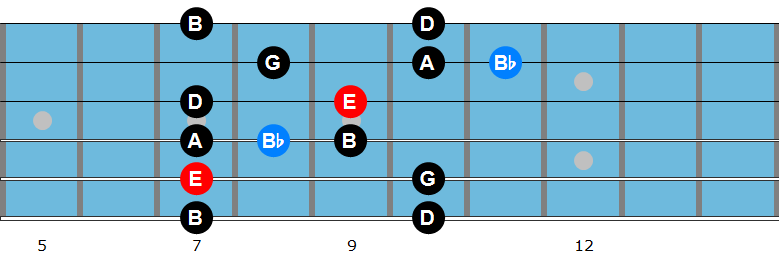

Minor Blues Scale Lick 4
The following 5 licks all use the F minor blues scale over an F dominant chord.
Listen & Play Along

Minor Blues Scale Lick 5
Listen & Play Along

Minor Blues Scale Lick 6
Listen & Play Along

Minor Blues Scale Lick 7
Listen & Play Along

Minor Blues Scale Lick 8
Listen & Play Along

Minor Blues Scale Solo
To finish our intro to the minor blues scale, here is a sample solo over an F blues. You can use the F minor blues scale over the entire blues chord changes.
Listen & Play Along
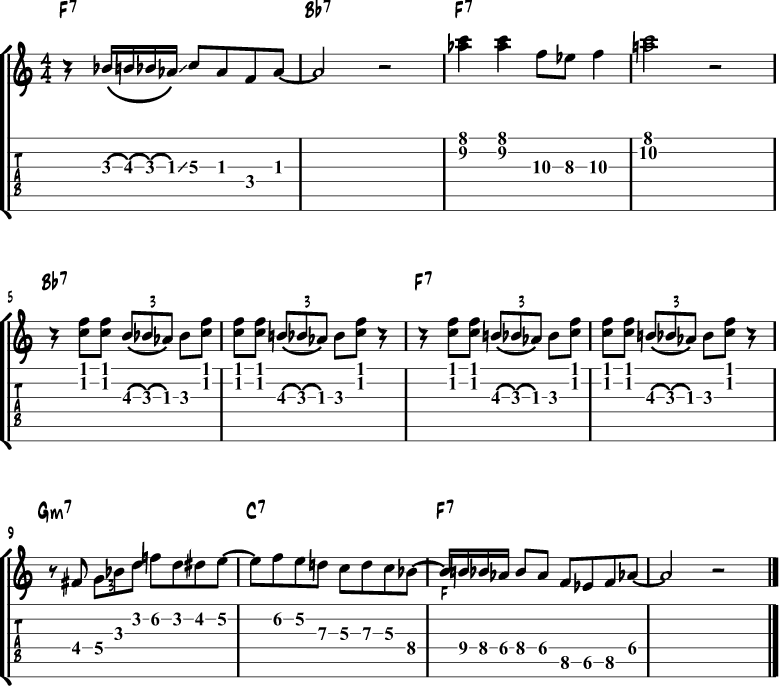
The Major Blues Scale
Just as its minor sibling, the major blues scale is an important melodic device that you can use to solo in many different musical situations and genres.
Major Blues Scale Construction
Let’s look at how to build this scale and how it is related to the major scale and the major pentatonic scale.
As you can see below, the major scale has 7 notes. The major pentatonic scale is made up of five of those notes (1, 2, 3, 5, and 6 of the major scale).
To produce a major blues scale, you simply take the major pentatonic scale and add in a blue note, the b3 of the key. This added note gives the major blues scale its bluesy vibe and separates it melodically from the major pentatonic scale.

Major blues scale = major pentatonic scale + blue note b3
| G Major Blues Scale | G | A | Bb | B | D | E |
|---|---|---|---|---|---|---|
| 1 | 2 | b3 | 3 | 5 | 6 |
Here is a sample two-octave fingering for the G major blues scale. Get it under your fingers so that you can begin to visualize this scale on the fretboard, and hear how it sounds on your guitar.

How to Use the Major Blues Scale?
There are two ways you can use the major blues scale in your solos:
- To outline maj7 chords (+ maj9 and maj6).
- To outline 7th chords (+ 9th and 13th chords).
The major blues scale works over both major 7 and dominant 7 based chords. This is because there is a major triad in the scale, but no 7th.
The 6th note of the scale can act to produce:
- Maj6 sounds over a major-type chord.
- 13 sounds over a dominant-type chord.
Major Blues Scale vs Minor Blues Scale
The main difference between the use of major and minor blues scales is that as the chords change in a blues or other standard form, you have to change scales along with them.
In a I-IV-V blues in the key of G (see in the last example of this lesson), you can play:
- a G minor blues scale throughout the entire form, or
- a G, C and D major blues scale for each of the three chords in the tune (G7-C7-D7).
This is the hardest part about learning to use the major blues scale.
The fingerings of the major blues scale resemble fingerings that you may already know for the minor blues scale but starting on different notes. This is the main issue players usually find when working on this scale, that it looks like the minor blues scale but isn’t played from the same root notes.
C major blues scale = A minor blues scale
The notes of the C major blues scale (C D Eb E G A) are the same as the notes from the A minor blues scale (A C D Eb E G), but they start on a different note and are used in another way.
So, make sure that you differentiate the major from the minor blues scales in your practice so that they are distinct and easy to move between when you apply them to your jazz guitar solos.
Major Blues Scale Diagrams
There are 5 main fingerings for the major blues scale. Here are the scale diagrams for a G major blues scale.

Major Blues Scale Licks
To help you get started with the major blues scale, and learn how to apply it to soloing situations, here are a few sample licks that you can learn, work in 12 keys, and use as the basis for your own lines.
Major Blues Scale Lick 1
This first lick is one of the most commonly used licks built from this scale.
To really get this lick into the swing style, try and accent the first and last notes (play them louder) of the lick. This will bring an emphasis to the outer notes of the lick, and add an extra layer of rhythmic interest to the line itself.
Listen & Play

Major Blues Scale Lick 2
The next major blues scale lick is based on a three-note repeated pattern (the b3-3-5 of the chord), that is reminiscent of the jazz guitar solos of Pat Martino.
Because the pattern is 3 notes long but played in an 8th-note rhythm, you are syncopating the lick so that it starts on a different part of the bar each time. This allows you to build energy in your solo, as well as use a repeated lick without it sounding boring.
Listen & Play

Major Blues Scale Lick 3
This last lick is over C7 and uses the C major blues scale.


Major Blues Scale Sample Solo
Here is a sample solo over a G blues chord progression. Start by playing the solo as written.
Then, play the first 8 bars as written and improvise the last 4 bars. From there, play the first 4 bars as written, and improvise the last 8 bars, before moving on to a fully improvised solo after that. This kind of transitional exercise is a great way to learn vocabulary, and integrate it into your playing at the same time.
Listen & Play
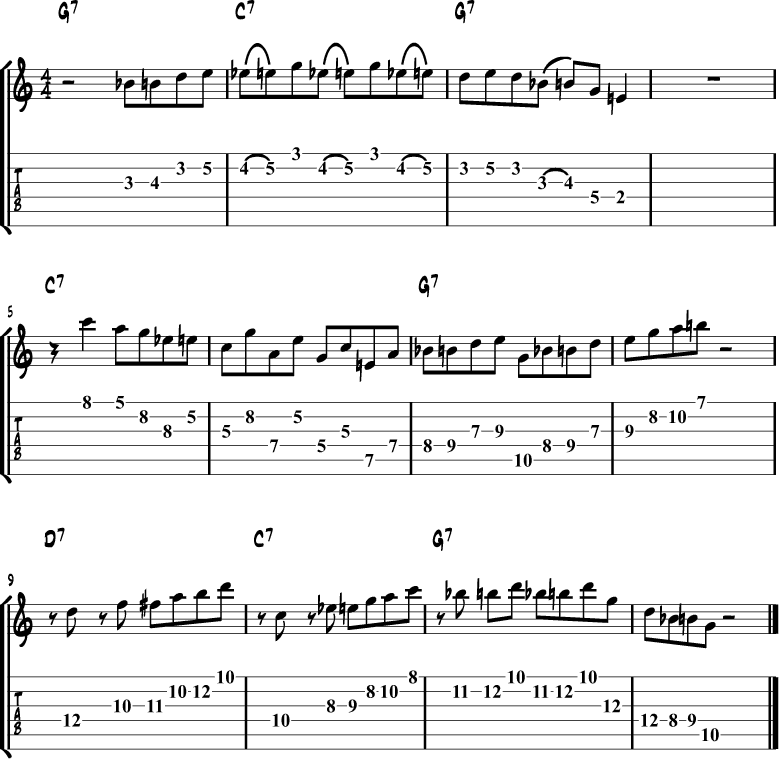
Major Blues Scale Theme
Here’s a tune called Full Count (written by jazz guitarist Chuck D’aloia) that uses the G major blues scale in its construction.
The blues scale is used in bars 1 to 3, and in the bridge. In other places it is mixed with chromatic notes and arpeggios.
Backing Track
Listen & Play Along
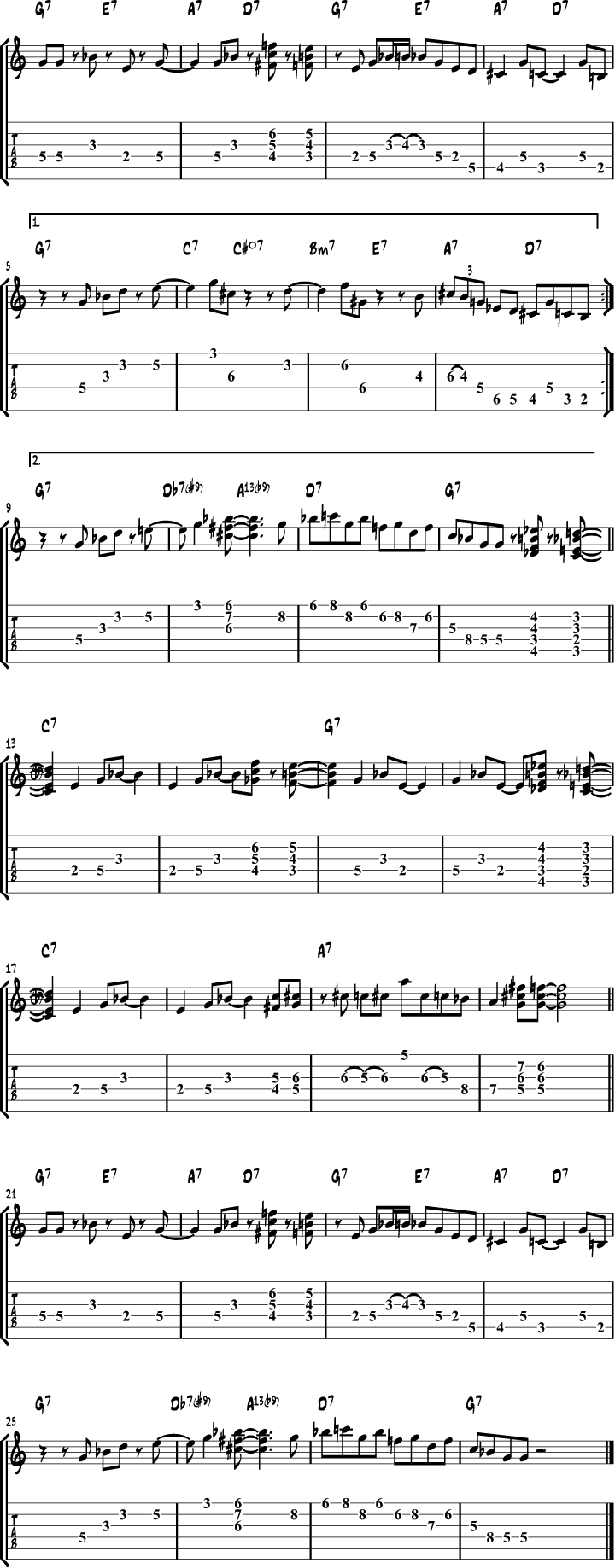
Mixing the Minor and Major Blues Scale
Here are some typical Joe Pass phrases over a blues in G in which he combines minor and major blues scales.
- Bar 1-8: the G minor blues scale all the way.
- Bar 3: chromatic approach of the 3 and b7 of G7.
- Bar 7: chromatic approach of the b3 and b7 of Bm7.
- Bar 8-10: mostly in the G major blues scale.
- Bar 11-12: G minor blues scale.
Backing Track
Listen & Play Along
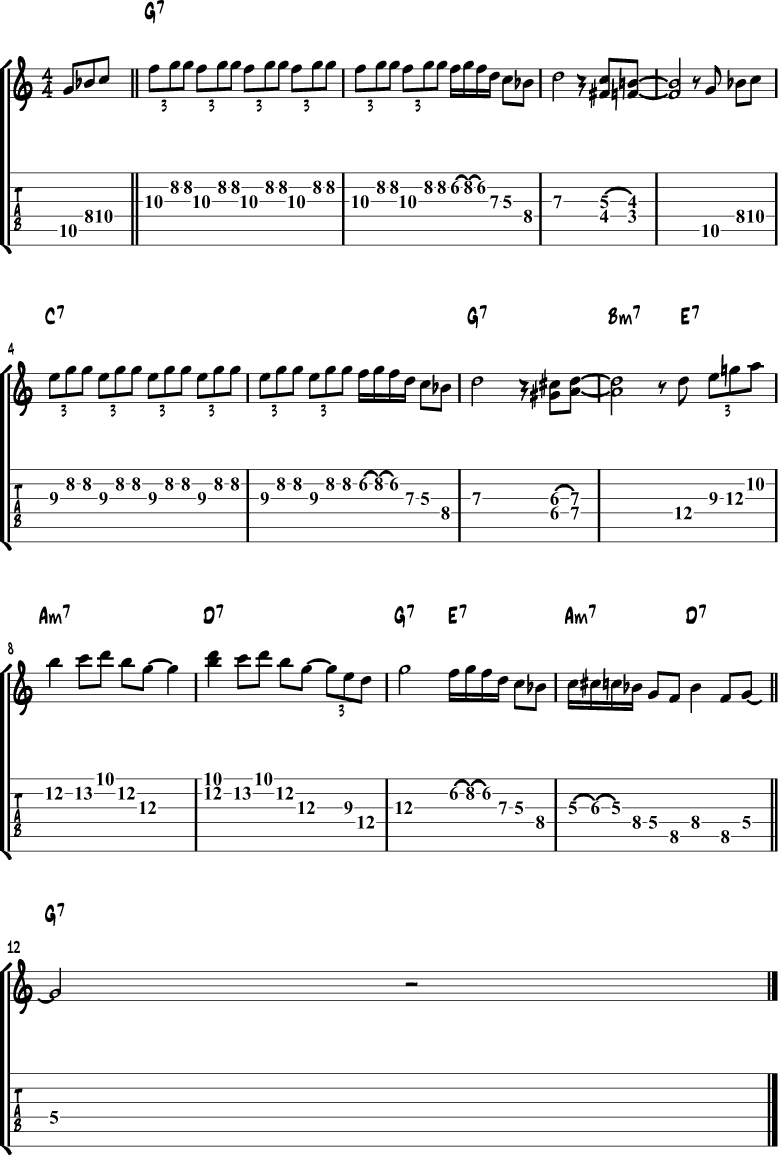
How do you use the blues scale in your jazz solos? Let us know in the comments below…


This is, by far, the most helpful resource I have found regarding the blues in general, and minor vs major blues, in particular. I wish I had run across this post several years ago.
I have immensely benefitted from this lesson on the blues scale. I will keep practising and guiding others on the blues scale. Your explanation is simple, concise, and articulate with adequate examples to provide efficient learning. Thank you. 🌼 ♥️
Hi Neel, thanks for the kind words, I appreciate your feedback!
Thank you so very very much for clearly explaining the differences between the Major Pentatonic Scale and the Major Blues Scale and the Minor Blues Scale – really got me looking at my fretboard differently. I struggle with lead guitar – mostly play chords and write songs, but want to keep expanding my knowledge. Your charts and explanations are great!
Very informative and educational Blues lesson. Probably one of the best I’ve ever seen because it’s application includes sound samples including scale samples.
I must conclude that I am a country Blues instrumentalist, this blues lesson would seem to lead me in the proper direction for note choice and combination of the major and minor blue scales. “Never underestimate the power of the Blues Scales”…
This is the best blues lesson I have found thank you for your thoughtfulness and kind consideration of your students…
Great resource. Really clear and complete!!
Very insightful and well laid out to follow for a beginner like me.
Thank you for this. Stumbled onto this, have mainly been trying to learn to play The Blues, but this is great to supplement that. (One item on the wish list – wish you also had a half speed version of each of these licks – but nevertheless, I’m slowly working my speed up – Thanks again.)
What are some bands that use or had used the major blues scale?
Great to know all this
Very educational but two points with respect.Backing track for me much to quick and no details of the correct mix for combined scales,Can the combined scales be used over all three blues chords over the 1 4 5 format”?
So if I understand correctly. E .g.
Standard Blues in A: A minor pentatonic over the A7, D7 and E7, and/or A major pentatonic over the A7, D major pentatonic over the D7 and E major pentatonic over the E7?
Hi Jacob, that’s correct. There are other permutations as well. Another common example: A major pentatonic over A7, then A minor pentatonic over D7.
This is so useful information! Thank you for sharing with us!
Excellent Blues guitar lesson. Thanks!
Glad you like the lesson, Dustin!
What is difference between g blues : G, Bb, C, Db, D, F
And your g major blues: G, A, Bb ,B, D, E….
Regards, rf
Hi Roger! The first one is the G minor blues scale, the second one the G major blues scale. You can use the G minor blues scale over Gm7 or G7 (among others), and the G major blues scale over Gmaj7 and G7 (among others).
Great lesson. Explained with competent simplicity.
Enfin on parle des deux gammes blues. Le premier accord des premiers blues et même de certains blues bebop était un accord majeur et non dominant. C’est donc la gamme blues majeure qui s’applique. Mais essayez de jouer un blues entier avec seulement une des deux gammes alternativement. Vous serez agréablement surpris. On peut aussi chercher l’harmonisation en accords de tierces de chaque degré de chacune des gammes .
Oeps…
G Major blues scale 5 shapes … Last two diagrams are given 1 fret to low. That is : 5th at 6 = 10th fret, where here you give 9th fret.
The rest of your content looks very nice!
Oops indeed… Fixed the issue, thanks for letting me know!
awesome!
awesome bluesy jazz lesson…will have to get right on it! thanks
amazing! lessons. Thank you very much!
This is really, really nice. Thank you!
Thank you for this. Brilliant work,
Wow what a great lesson indeed . Thankyou DIRK !
Thanks for your sample e-mails,
They have opened up a new world of
jazz improvisation to an old rocker like me.
I stumbled upon his video lesson of Blues Guitar and was amazen. The man seems to have little at first but when he starts explaining its almost like he forms your thoughts together. A very good teacher. Influenced my love for Blues further.
Very good, thank u Dirk.
Thanks,this is my favorite jazz guitarist. I like his scales…
Pretty nice sound. I love it.
I am learning sooo much with this :).. thanx
These are superb lessons thanks.
thankyou very much remind me some old stuff in band in box..thanks again.
thanks sir. i like ur site.thanks.keep it up.
I like ur site
This is a wonderful site, I keep trying to make use of it, and support it but always get caught up in other things demanding my time and forget about it. The e-mails remind me of what I should really be doing, learning more guitar….please keep sending them to me. I intend to make an effort to support the sites I make use of in the near future Thanks kevin c
Dirk,
Thanks for posting this interesting Solo, the solo goes well with “Further Up On The Road” I changed the timing and tweaked the sound a little. It adds to my arsenal of blues licks. Thanks again!
Thank you very much for sharing this, it’s a great lick!
Bingo Geoff! I have read (and heard in his playing) exactly that about Joe. I understand when Joe was a kid just learning the guitar, that his father (not a musician) told Joe to copy tunes off the radio and encouraged him to create fills and solos as many different ways he could.
This is a great treat! Thankyou
Cool stuff Dirk, Thanks for posting.
Great solo! I love JP, Thanks !
I will give this a GO tonight! I can’t wait.
Thanks Dirk. This is a really ‘manageable’ piece for someone of my standard, and really great to have the backing track to play along with.
Thanks a million, nice stuff.
Enjoy the format. Thanks for posting these very enjoyable works.
Excellent lesson: nice selection, cogent analysis. Thanks for all your good efforts, Dirk!
Great phrasing, always loved Joe Pass, thanks Dirk!
Cannot stop playing it in my mind.
A big THANKS
Thank you, it’s very usefull
paolo
Wow, I haven’t done any of this sort of thing in ages but you have inspired me to have another go. Tonight the work begins! Thanks for this.
Thanks for the email .. Beautiful performance
Super! Just what I was looking for!
excellent stuff!! looking forward for the next posts.
Dear Mr Laukens
Thank you so much for your work ,your site is definitly n.1 on Blues and jazz guitar
(my late dad was technical manager at the JAZZ a Juan summer festival in France for
over 15 years)so i had the chance to meet with a lot of great artits,your feeling is
true and your explanations are great.
I m not pretty wealthy at the moment but i will support your site as soon as i can.
Thanks again Martial
Hi Dirk, great solo. Working on it now.Could take a while to master it (Huh!)
Thanks.
I enjoy the Joe Pass lesson Joe is using G minor pentatonic in the turnaround of the blues I like that.
Merci
That was nice. Thanks.
That is some fine jazz dining.I was getting a little hungry for some Passta.This place is always a class act.E
Cool. I love it. Keep posting!
Very Nice Dirk, I love your E-mails they have helped my style a great deal, Thanks!
LOVE Joe Pass!!!
I can’t wait to give this a spin tonight!
Joe Pass the real Boss I will really miss him The guitar man
Thank’s for that nice, swinging jazz blues solo, I have trouble with bar 4 in blues, most time I just play something some time it sound O.K. other times it’s bad. WHY?
Your friend Gene Pierce
YEA,I HAVE ALREADY NOTICED A DIFFERENCE IN MY PLAYING AND ITS ONLY BEEN A COUPLE WEEKS,I AM LEARNING WHAT I WANT TO LEARN,THANKS DIRK,THESE LESSONS ARE GETTING ME WHERE I WANT TO BE!
You helped me about major 6 arpeggios now I’m understanding, for your course immediately ill be the best jazz improviser .I’m very I want to learn more from you.
den beste hjelp man kan få son amator tak!!
So bluesy. Very interesting the use of all the thirds…
Love it ! Old school
Cela me plait beaucoup mais, à mon niveau, il m’est encore difficile a jouer.
Nice sounds, glad to play it, thanks Dirk
Wow! That was great!
How do you get that beautiful tone?
What gear do you have?
Thanks Georgez, I play on a Heritage H575 through a Roland JC-120 amp.
Thanks Dirk.
You have a ludic way to teach jazz guitar playing.
Wonderful!
Very nice!
Sounds so good!
Bless
Like it! Great job & thanks.
Mal
very good!
thank you
Very great job – this and the other helpful material! Thanks a lot!!
Wow!
Thanks for the great Melodic and Harmonic concepts that you share, plus the inspiration and motivation which is the essence of teaching. Please keep it coming.
Keep playing this … very cool jazzing … 😉
great materials guys. thanks a lot, please keep doing it 😀
Thanks. This is one terrific site.
Very very cool !
Very nice!! I will probably start to work on it tomorrow. I’ve been working on the other stuff you sent. Jazzy blues is very nice. j
Do you have any examples of, I think it’s called, a running line of improvisation??
Or an on-going line? I’d really like to learn what that is all about.
Thanks for all the help!
Rick
You guys offer such a fine uncluttered medium to learn jazz guitar, and the music history of jazz pioneers. Especially for those of us that are new to playing jazz. This tune is basis enough to not be over-bearing, thus learning it will be pleasurable. Thanks guys.- My best-Dave
Hey Dirk, i was wondering when you were going to update your newsletter as I thought it had so much to offer the musician. I have practiced from it and I have met other jazz players such Chris Standring and was amazed by his sound and his ‘Play What You Hear”. Your videos were specific to the needs of the guitarist and there are not many Jazz sites that give lessons as good as yours. Very informative.
Very nice thank you!
Nice
I think this is a great way to learn jazz. I love it ..thanks guys
Hi my sincere congratulations for your website. It is a very useful tool for musicians who wAnts to learn about the jazz world theory and practicing elements. I am very satisfied with the content you show here. It is very clear and the music sheets and pay along backing tracks and your track recordings of each song make very understandable each topic. Thumbs up for your well done job. Greetings. Cesar Coronel.